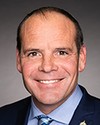Thank you very much for having me, Mr. Chair. Maybe you can just signal me when I get to one minute, and I'll scoot on through and do that. I want to make sure I respect the committee's time here.
I'm really pleased to be here and present Bill C-248. Members of this committee know that it was in the House of Commons and it passed first reading. I want to thank the authors of the bill, being the Library of Parliament, who helped work on it. It's a privilege to bring this legislation forward, and to be the one doing so. This has been a big environmental movement in the Windsor area and southern Ontario for a long time. We have been endeavouring to protect lands in this area for almost half a century, in particular because of our industrialization and the fact that we also have a lot of agriculture, so our natural areas have been taxed.
I want to say thanks to a number of groups, essential partners. I recognize Chief Duckworth of Caldwell First Nation; the mayor and city council of Windsor; Wildlands League; the Unifor environment committee; Wildlife Preservation Canada; Citizens Environment Alliance; Essex County Field Naturalists' Club; Green Ummah; Friends of Ojibway Prairie; Save Ojibway organizations; and all the local residents over the years who have sent in thousands of petitions, letters and so forth. It's been really special.
The proposed Ojibway national urban park here in Windsor, Ontario, is part of the traditional territory of the Three Fires Confederacy of first nations and includes the Ojibway, Odawa, and Potawatomi, with long-respecting relationships of first nations. In fact, it's the oldest European settlement. Next to it is west of Montreal, with over 300 years of francophone settlement as well. It's where the War of 1812 was fought. It's where the Underground Railroad was. It is also where the rum-runners were. There has been a lot of heritage and tradition going on in this corridor.
The proposed urban park that we have here is part of a tall grass prairie. There's only 1% left in all of Canada, and this area is very special, because it's been preserved almost by accident. There have been a number of different community organization groups that have been trying to protect this land over a number of years, and it's come about, really, because the City of Windsor has been a very good steward—as well, the Province of Ontario. There have been some federal lands—I'm going to get into that later—that are now part of a change that could be good not only for 200 of Canada's 500 endangered species that are right down there, but also for ecotourism. Right next to it, we're building the Gordie Howe bridge, Canada's largest infrastructure project that goes into the United States.
Ojibway Shores, on the waterfront there, is 33 acres. It is the last undeveloped spot along the Detroit River in the City of Windsor and in the area, and maybe in the Great Lakes. It actually has a complex of a number of different tall grass prairie species and a number of different species at risk. They connect into several of the properties that the City of Windsor actually owns, and the Province of Ontario. Ojibway Shores itself is actually owned by the port authority.
Since the introduction of this bill, I, as well as others in the community, have been trying to save this land from development. It is now actually on a memorandum of understanding with Parks Canada and Environment Canada to protect it. It's crucial, because at one point the port authority wanted to bulldoze this area down and develop it, using it basically for landfill from the Herb Gray Parkway project. That's now protected. When it was inventoried by the field naturalists, it actually ranked high as some of the most valuable property for the ecosystem in Ontario.
There are several areas that I'm going to touch on briefly that connect into this. There's Spring Garden Natural Area, which is the City of Windsor. I was on city council when we protected that. It has everything from the Dukes' skipper to the red-headed woodpecker, the gray fox, all kinds of different American chestnut trees—a whole series of ecosystems there. Because we're actually a Carolinian area, and off the water, it creates this ecosystem diversity and a hot spot for species.
There's also the Black Oak Heritage Park, which is next to Ojibway Shores. So, Ojibway Shores is right on the waterfront, and then Black Oak Heritage Park, a City of Windsor property, is right next to it. We have the port property right next to the city property, but there's no management system there that's for both together. They have savannah and woodland species, and some of the best chestnut groves that are left in Ontario.
Next to that is the Tallgrass Prairie Heritage Park, where there are a number of different things—the red-bellied snake, Butler's gartersnake, the eastern foxsnake, and common park reptiles. In 1977, they found a species that they thought was extinct in Canada that was actually still there. That connects to it as well. Then we have Ojibway Park, which is next to it and has an excellent nature centre.
I think you're getting a theme here. We have these little plots of land that are owned by different people and different groups. This actually has a nature centre, walking trails, a beautiful ecosystem. It's also had some private areas given to it from the former raceway with Ojibway Tom Joy Woods. Next to that, we have the Ojibway Prairie Provincial Nature Reserve. There are more rare plants per hectare than anywhere else in Ontario. That's really cool in itself, if you ask me, in terms of what we have around us there.
What's really special, however, and why I think this is different from the other urban parks that are being considered, is that right across the river, in the United States, is the Detroit River International Wildlife Refuge, which is the only one that they have over there. Across in the United States, if you saw the area.... You'd see that on the Canadian side we have the bringer bridge being built, and then we have a swath of green, patchy territory that needs to be connected and managed. On the U.S. side, if you're fan of The Lord of the Rings, Zug Island looks like Mordor. It's not very attractive, but there's also another community that's getting revitalization, called Delray. This is exciting because Delray is like Sandwich Town, which I represent and which is one of the poorest places in Canada with child poverty.
Again, I mentioned the rich tradition that it has had in the past, with the War of 1812, the rum-runners, the Underground Railway and all of those things. Right now, however, it has some of the highest child poverty and some of the biggest challenges with the environment because it's pinned down in this border area, with the Ambassador Bridge on one side, a railroad track on the other, and the Detroit River on the other. It's an exciting renewal opportunity that we're pleased about.
On the Detroit side, they are putting a lot of money into the Humbug Marsh and a whole bunch of ecosystems. What this means is that this property is a conduit for keeping things together and for species to migrate and move.
About 12 years ago, local residents fought to keep Ojibway Shores from being bulldozed. There's a long story behind that. I won't get into that. Next to it, again, the Gordie Howe bridge is being built. That's actually going to come online in a couple of years. That's exciting. That's been a real fight. That's actually an example of doing things right.
When I first got here, nobody wanted to build another bridge. It was seen as excessive. It was seen as not needed. We're doing it right. It's a fantastic project that was actually started by Jean Chrétien with the original “Let's Get Windsor-Essex Moving” fund for $200 million. Then, later on, it was actually finalized with Stephen Harper's government. They did a terrific job of making sure it was done correctly, because there were a lot of private interests against this. Now it's unified—everybody. It's a huge win for our environment and our economy. That's right next to it.
What happened in 2017 is that, after we stopped the destruction of Ojibway Shores, the port authority changed their mind and let people on board onto the site. There are 10 criteria of Ojibway Shores to find out whether it's environmentally significant. One is good enough. They had nine out of 10. I won't list them all because we don't have time, but it got nine out of 10 because of the way the ecosystem is and because of our Carolinian background.
I've been on about this for a long time. We had a town hall in 2019 where I invited not only the residents but also Caldwell First Nation and the Wildlands League. A number of different American state and federal officials also came. We've had a really good, positive input with that.
We followed it up with another town hall meeting just recently as well. In fact, even when the Prime Minister was down in Windsor in 2020, he said to the union leaders at that time that he supported a national urban park down there, so that was good.
In 2021, I introduced Bill C-248 because there had been some discussion of some new urban parks that might come online. What we wanted was simply what's been done for every other national park to date. It has its own legislation, just like a bridge or a border crossing. That's what we're doing. We're amending the schedule in the parks act to add this area.
I only have one minute left to wrap up. I would rather have interactions with everyone. One of the good news things that happened is that introducing the bill has actually triggered the memorandum of understanding for the Ojibway Shores to be protected from the port authority. The people at Parks Canada were opposed to co-management with Caldwell First Nation at first. To their credit, they have now changed positions on co-management, which is becoming the norm with first nations. It's important.
I'll finish with one of the most wonderful things we've seen happen out of this entire endeavour—a brief history as I wrap up. Caldwell First Nation was originally supposed to get Point Pelee after the War of 1812. They were burned out of their properties, and they were then shunted around for a number of years. They finally reached a settlement. It's the first new modern settlement that's actually taken place. They view this as reconciliation and are full-time partners in this. It's a wonderful story in terms of that. Chief Mary Duckworth has been excellent with this. Hopefully you will hear from her later.
I want to say thank you to the committee members for considering this, and I'm looking forward to the questions.






